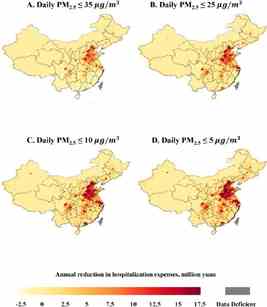Short-Term Exposure to PM2.5 Increases Hospital Admission Risks and Costs in China
Published 24 June, 2023
In a worrying revelation for global health, fine particulate matter, specifically particles with an aerodynamic diameter of less than 2.5 μm, has been flagged as a serious threat to populations around the world. A recent article authored by researchers from Tsinghua University and the China Standard Medical Information Research Center sheds light on the grave consequences of short-term exposure to PM2.5, which can elevate the risks and expenses associated with hospital admissions for various major diseases. The findings, published in the journal Global Transitions, further accentuate the alarming implications of this issue.
"In recent years, there has been a noticeable improvement in China's air quality level," said the study’s co-corresponding author Ting Chen, a professor in the Department of Computer Science and Technology at Tsinghua University. “It is nonetheless important to accurately assess the positive effects resulting from the reduction in air pollution. To quantify these benefits, we conducted a time-stratified, case-crossover study to investigate the correlation between short-term exposure to ambient air pollution and various health-related factors, including hospital admissions, length of hospital stays, and associated costs."
The team found a positive association between the risks and costs of hospital admissions and short-term exposure to fine particulate matter (PM2.5) in all major diseases. According to the study's findings, a 10 μg/m3 rise in PM2.5 concentration level (adjusted for ozone) was associated with a 0.27% increase (95% confident interval (CI): 0.25%, 0.29%) in hospital admissions. Additionally, this elevation was linked to a surge of CNY39 (95% CI: 36.11, 41.89) in hospitalization expenses per admission and an extended duration of hospital stays by 0.0280 days (95% CI: 0.0259, 0.0300) per admission.
“Moreover, the relative risk increases of mental disorders, respiratory diseases and circulatory diseases showed significant associations with short-term PM2.5 exposure,” explained Qian Di, lead author of the study and an associate professor in Vanke School of Public Health at Tsinghua University. “Based on our calculations, improved air quality since 2013 saved CNY2.28 billion in medical expenses in 2017. We anticipate that this evidence can inform governmental policies concerning environmental preservation.”

Image: Hospitalization expense reduction under different PM2.5 standards in China in 2017.
Contact author details:
- Qian Di, Vanke School of Public Health, Institute for Healthy China, Tsinghua University, Beijing, China, qiandi@tsinghua.edu.cn.
- Ting Chen, Institute for Artificial Intelligence, Department of Computer Science and Technology, BNRist, Tsinghua University, Beijing, China, tingchen@tsinghua.edu.cn.
- Haibo Wang, Clinical Trial Unit, Sun Yat-sen University First Affiliated Hospital, Guangzhou, China, Haibo@mail.harvard.edu.
See the article: Gao Y, Gu J, Shi Y, et al. Association of short-term exposure to ambient fine particle matter with hospital admission risks and costs in China, a case-crossover study[J]. Global Transitions, 2023, 5: 40-49.